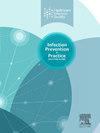Association of antimicrobial consumption with Clostridioides difficile incidence across the departments of an academic medical centre
IF 1.9
Q3 INFECTIOUS DISEASES
引用次数: 0
Abstract
Background
Clostridioides difficile infection (CDI) is a common gastrointestinal disease in healthcare settings, ranging from uncomplicated diarrhoea to life-threatening pseudomembranous colitis. It is associated with increased morbidity, mortality and healthcare costs. The aim of the study was to correlate CDI incidence with total and specific antibiotic consumption across 17 clinical departments of an academic hospital.
Methods
This retrospective correlation study used data on CDI and antibiotic prescriptions from 1.1.2008 to 31.12.2021. CDI episodes were defined using CDC criteria. Antibiotic consumption was reported per WHO in defined daily doses (DDD). A mixed effects logistic regression model was fitted with each department as random effect to determine CDI incidence as a function of year and adjusted for antibiotic consumption.
Results
Amoxicillin-clavulanate showed the highest annual consumption across the 17 departments (median 13.5 DDD/100 patient-days). The average CDI incidence was highest in nephrology (22.3/10′000 patient-days) and lowest in otorhinolaryngology (0.1/10′000 patient-days). We observed an association between overall antimicrobial consumption and CDI incidence (incidence risk ratio (IRR) per 10 DDD/100 patient-days of 1.16, 95% confidence interval (1.09, 1.23), P<0.001). When plotting each department's CDI incidence against the departmental average annual consumption, no significant trend was found; however, there was a trend for the association between CDI and selected antibiotic usage, such as carbapenems (P=0.003), ceftriaxone (P=0.04), cefepime (P<0.001), macrolides (P<0.001) and piperacillin/tazobactam (P=0.03).
Conclusions
We detected an association between antibiotic consumption and CDI incidence across the departments of an academic hospital; however, we could only correlate departmental CDI incidence with the usage of select antibiotics.
抗微生物药物的使用与艰难梭菌的发病率在一个学术医疗中心的部门之间的关系
艰难梭菌感染(CDI)是一种常见的胃肠道疾病,从简单的腹泻到危及生命的假膜性结肠炎。它与发病率、死亡率和医疗费用增加有关。该研究的目的是将CDI发病率与一家学术医院17个临床科室的总抗生素和特定抗生素用量联系起来。方法采用2008年1月1日至2021年12月31日CDI与抗生素处方数据进行回顾性相关性研究。CDI发作的定义采用CDC标准。按世卫组织规定的每日剂量(DDD)报告了抗生素消费量。采用各科室随机效应拟合混合效应logistic回归模型,确定CDI发病率随年份的变化,并对抗生素用量进行调整。结果在17个科室中,克拉维酸莫西林的年消耗量最高,中位数为13.5 DDD/100患者天。平均CDI发生率以肾脏病科最高(22.3/10 000患者-d),耳鼻咽喉科最低(0.1/10 000患者-d)。我们观察到总体抗菌药物用量与CDI发病率之间的关联(每10 DDD/100患者-天的发病率风险比(IRR)为1.16,95%可信区间(1.09,1.23),P<0.001)。将各部门的CDI发病率与部门的年平均消费量进行对比,没有发现明显的趋势;然而,CDI与某些抗生素的使用有相关性,如碳青霉烯类(P=0.003)、头孢曲松(P=0.04)、头孢吡肟(P= 0.001)、大环内酯类(P= 0.001)和哌拉西林/他唑巴坦(P=0.03)。结论:我们发现某学术医院各科室抗生素用量与CDI发病率之间存在关联;然而,我们只能将部门CDI发生率与选定抗生素的使用联系起来。
本文章由计算机程序翻译,如有差异,请以英文原文为准。
求助全文
约1分钟内获得全文
求助全文
来源期刊

Infection Prevention in Practice
Medicine-Public Health, Environmental and Occupational Health
CiteScore
4.80
自引率
0.00%
发文量
58
审稿时长
61 days
 求助内容:
求助内容: 应助结果提醒方式:
应助结果提醒方式:


